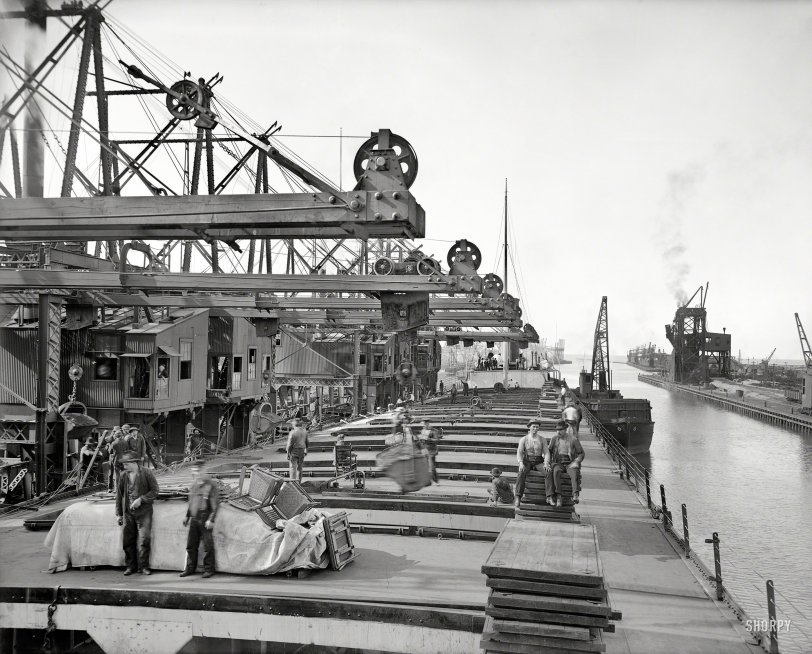


Framed or unframed, desk size to sofa size, printed by us in Arizona and Alabama since 2007. Explore now.
Shorpy is funded by you. Patreon contributors get an ad-free experience.
Learn more.

- Freeze Frame
- Texas Flyer wanted
- Just a Year Too Soon
- WWII -- Replacing men with women at the railroad crossing.
- Yes, Icing
- You kids drive me nuts!
- NOT An Easy Job
- I wonder
- Just add window boxes
- Icing Platform?
- Indiana Harbor Belt abides
- Freezing haze
- Corrections (for those who care)
- C&NW at Nelson
- Fallen Flags
- A dangerous job made worse
- Water Stop
- Passenger trains have right of way over freights?
- Coal
- Never ceases to amaze me.
- Still chuggin' (in model form)
- Great shot
- Westerly Breeze
- For the men, a trapeze
- Tickled
- Sense of loneliness ...
- 2 cents
- Charm City
- What an Outrage
- Brighton Park
Print Emporium
Ore Hoists: 1900

Lake Erie circa 1900. "Unloading ore at Conneaut, Ohio. Brown conveying hoists." 8x10 inch glass negative, Detroit Publishing Company. View full size.
Incredibly interesting
I forwarded this to my daughter the engineering student and she was impressed. Thanks to Clare for the link to the video of the Hullets.
18 men and 1 Brown Unloader could unload 100 tons per hour
For "tons" of information on the unloading of ore boats and more, see
the Google ebook
- Iron Ore Transport on the Great Lakes: The Development of a Delivery System to Feed American Industry
by W. Bruce Bowlus. "This detailed history recounts innovations in shipping, the improvement of channels and harbors, the creation of locks, technical advances in loading and unloading equipment..."
A preview of the book is available at http://goo.gl/pukcj4 (try searching the book for [Brown]
Hand shoveling, Browns, and Huletts
Yes, the Huletts were a giant leap in unloading iron ore, stone, etc. over the Browns, but before the Browns, there was hand shoveling. So, the Browns revolutionized cargo unloading, and then the Huletts did it again.
BTW, the Huletts in the video were in Cleveland. Several were scrapped and several were dismantled.
Brownhoists
The Brownhoists were all gone by 1981. Ore would have been unloaded by Huletts, which were incredible machines. Here is a link to a You Tube video of them.
Notice tied up alongside this ship is the ubiquitous "bum boat". literally a floating general store, found in almost every Great Lakes port back then. I think they are all gone except perhaps the one in Duluth.
Brown Conveyor Unloaders
Wow! Those things must have taken FOREVER to unload even a small boat (on the Great Lakes vessels in captive service on the lakes are called "boats", not ships) of, maybe, 5,000 tons.
I've never seen a picture of one of these before.
The only way I can visualize, at that time, to fill that bucket suspended from the trolley of the conveyor is to have workers hand shovel the ore in the hold into the bucket! In those days, laborer really meant LABORer.
I've always thought the Hulett unloaders that unloaded boats for the next half a century were clumsy, but they were sure a vast improvement over these Brown monsters.
Todays conveyor equipped "self-unloader" boats are a quantum improvement over the Huletts.
A transportation vehicle (railroad car, semi-trailer, boat/ship, stagecoach, or aircraft) only makes money for its owner when it's moving. Anything that can reduce terminal time is money in the bank.
Didn't change much for 80 years.
During college (1981), I worked on an ore ship. The Str Paul H. Carnahan- National Steel Corp. It was one of the last ones on the lakes that didn't have a self-unloading boom. When we went from Duluth to Cleveland or Sandusky or, yes, Conneaut, we were unloaded with this same type of machinery.
It might have been updated with Diesel power or Electricity - I don't remember.
I worked in the Galley, so I didn't have to deal with opening the hatches as in the pic.
Ahhh... youth.
























On Shorpy:
Today’s Top 5